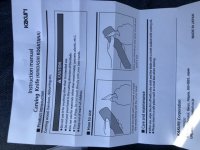I'm surprised this thread hasn't turned towards the various cue tip maintenance tools out there. One would think that by now, by 2021, there would be a superbly functioning, quality tip tool, for installing, cutting, shaping, etc. But, alas, to my knowledge there is not.
Memory fails me but there was or is a real nice tip tool. Close to two hundred, and you could do everything with this tool or tools. A pool hall owner had one, and that is what you would have to be to justify it. With the new prices for tips and putting them on if that set up is still available it seems much more reasonable now. Of course you can get a drill powered lathe set-up for the same dollars for some pretty nice ones.
I’ve done plenty of tips and the bevel on the outside of the ferrule is very easy to control. I can see no reason to turn it around to bevel in.
The only reason to use the knife as intended is to pursue a bit of knowledge. I will be surprised if it is head and shoulders better than the way we instinctively want to use the tool. However, if it is noticeably better we have all learned a little, letting Dave do the work and have the risks of trying something new. What can be better than that?(grin)
As demonstrated by the draw knife, I use whatever is handy and sharp. Almost everything I have has a double bevel so it is just the same either way. traditional woodturning on the lathe is much more particular about bevels and such. I do consider how I am holding my tool very carefully doing traditional turning. At least three basic angles of attack, some more exciting than others! Traditional tools and methods can make you dead if you are careless. On the other hand, you can get away with more with experience, as long as you know what standards you are crowding. Anyway, after turning wood awhile I am more aware of bevels and bevel positions.
If I had the knife on hand I would try the way the people making it meant for it to be used. However, as I have already pointed out, it wasn't designed for tip work, heavy work either unless I am mistaken about heavy work. However, I think the handle is proof it isn't intended for cutting timber. I'm wondering if the bevel height being about the same as the thickness of the material has something to do with the technique used by the original users of the knives.
One of the tricks to working with a lathe to put tips on is to recognize that the double bevel blades like common utility knife blades have a negative rake when the blade is horizontal to the ground. Tilting the blade up just enough to take away the negative rake, maybe have a few degrees of positive rake, is one of the tricks to doing a really nice job on a tip install. Does any of this apply to hand use? Maybe Dave can tell us after he plays with his new knife awhile.
Hu
